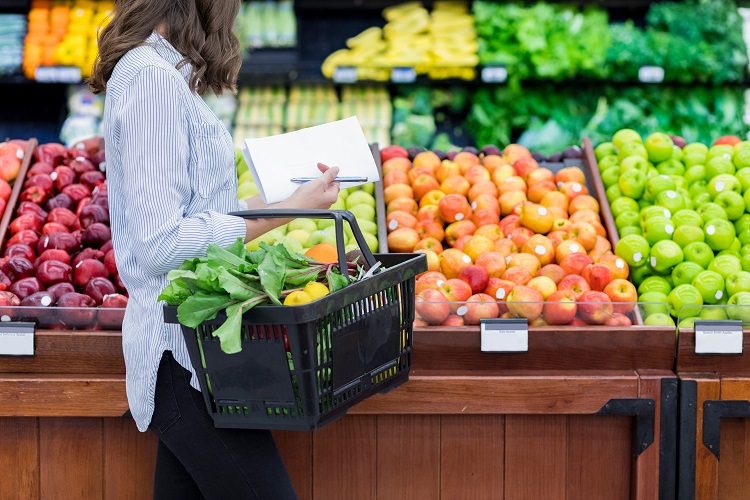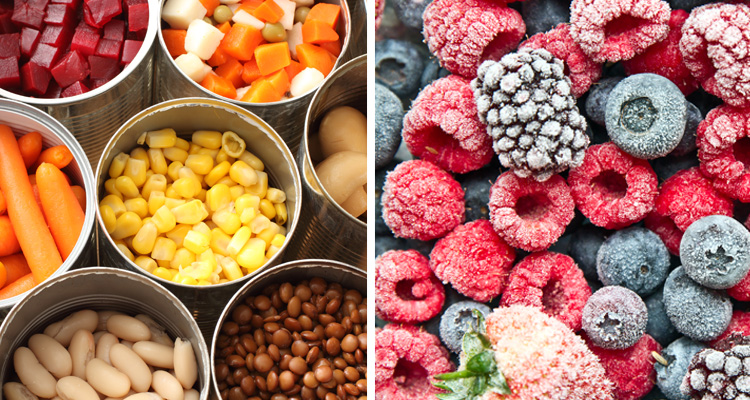Grocery shopping can be challenging when you are on a tight budget, especially when you are trying to purchase enough fruits and vegetables to get the recommended five servings each day for each member of your family. However, there are ways that you can get five servings of fruits and vegetables each day and stay within your budget. Here are a few tips that may help:
Before you shop do the following:
- Plan your menu for the week before you go shopping. Try to include meals that you can make in large batches and use for lunches or for another dinner later in the week, such as soups, casseroles, and stir-fries.
- Make a list of the food you need to buy. Making a list will help keep you from buying items you do not need.
- Join the store loyalty program. Many stores have loyalty cards. When you use these cards, you can buy items at a lower price. You may also get special offers and coupons that non-members do not get.
- Cut coupons to save money. Remember that coupons only help if they are for items you usually buy. Remember another brand can still cost less even after you use a coupon.
- Eat before you shop. Grocery shopping when you are hungry makes it more likely you will buy items you do not need and often leads to making unhealthy food choices.
At the store:
- Buy fruits and vegetables when they are in season. Fruits and vegetables cost less when they are in season. Some fruits and vegetables cost less year-round, such as bananas, apples, oranges, cabbage, sweet potatoes, dark-green leafy vegetables, green peppers, and carrots. You can find a list of what’s in season here https://snaped.fns.usda.gov/seasonal-produce-guide
- When you buy fresh produce, purchase in their whole form. Pre-cut and pre-washed produce is convenient but often costs much more.
- Purchase frozen fruits and vegetables. Frozen food is convenient, nutritious, and economical. Purchase multiple bags of frozen fruits and vegetables when they go on sale. You can also freeze fresh fruits and vegetables, when they are in season, to use later. Choose fruit canned in 100% fruit juice and vegetables with “low-sodium” or “no salt added” on the label.
- Buy canned fruits and vegetables. Canned fruits and vegetables usually cost less than fresh, and they are just as nutritious. Purchase fruits canned in water or in their own juice instead of canned in light or heavy syrup. Look for fruit canned in “100% fruit juice.” For vegetables, purchase low-sodium varieties. Look for “low-sodium” or “no salt added” on the label. You can also rinse canned vegetables to remove some of the sodium.
- Stock up on fruits and veggies that are on sale. When there are specials on fruits and vegetables, try to stock up if they are frozen or canned. If there is a special on fresh produce, try using it in several meals that week. For example, if broccoli is on sale, use it fresh in salads for lunch and in casseroles or a frittata for dinner.
- Try buying store brands. Most stores offer their own brand of products that often cost less than name brands.
Use leftovers:
- If you have leftover fruits and vegetables that are about to go bad, try using them so you don’t waste money. Most fruits and many greens, such as spinach and kale, can be used in smoothies. Fruits can be used on cereal, oatmeal, and ice cream. Many vegetables can be added to soups and casseroles. Or, display the fruits and vegetables you have on a plate with your families’ favorite dips as a snack!
Additional Resources:
Buying Fruits and Vegetables on a Budget: https://extension.psu.edu/buying-fruits-and-vegetables-on-a-budget
Fruits and Vegetables on a Budget: https://www.fruitsandveggiesmorematters.org/fruits-and-vegetables-on-a-budget
10 Tips: Smart Shopping for Veggies and Fruits: https://choosemyplate-prod.azureedge.net/ten-tips-smart-shopping
Are Canned Fruits and Veggies as Healthy as Fresh: https://5210.psu.edu/canned-frozen-fruits-veggies-healthy-fresh/
Create a Grocery Game Plan: https://choosemyplate-prod.azureedge.net/sites/default/files/budget/grocery_gameplan_interactive.pdf





